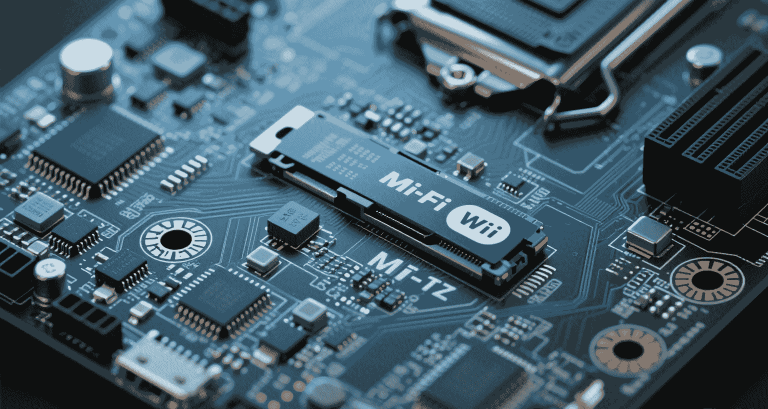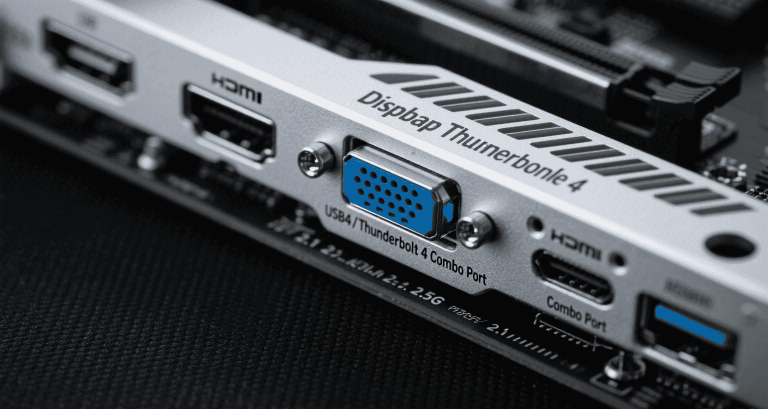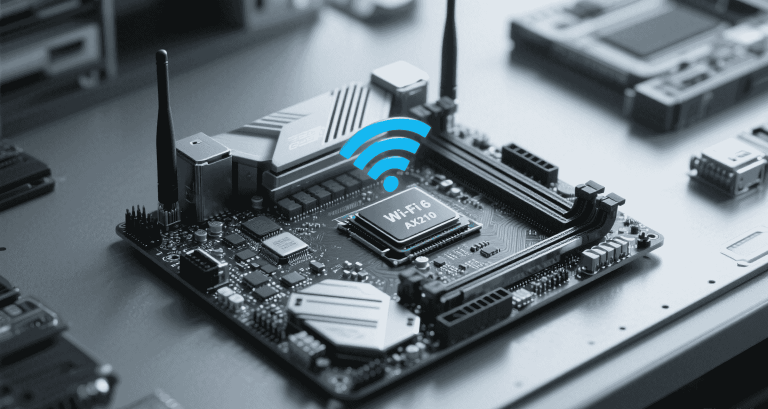Mini‑ITX Motherboards with M.2 Wi‑Fi Slots
Table of Contents
- Introduction
- M.2 Slot Types and Keying for Wi‑Fi Modules
- Wi‑Fi Standards and M.2 Module Capabilities
- Antenna Engineering and Signal Performance
- BIOS and OS Compatibility Challenges
- Module Installation and Mechanical Fit Issues
- Power and Thermal Constraints in Dense Boards
- Signal Reliability and Performance Testing
- Recommended M.2 Wi‑Fi Modules and Use Cases
- Mini‑ITX Boards Featuring M.2 Wi‑Fi Slots
- When to Use External vs M.2 Wireless Options
- Final Integration Recommendations
Introduction
For modern embedded and compact systems, robust Wi‑Fi is no longer a luxury—it’s a design requirement. Mini‑ITX motherboards with onboard M.2 Key‑E slots make it possible to integrate high-performance wireless communication without bulky dongles or unreliable external devices. In system-critical deployments—HTPCs, IoT nodes, mobile test platforms—using the right M.2 Wi‑Fi module is essential for maintaining signal integrity, bandwidth, and physical layout constraints.
M.2 Slot Types and Keying for Wi‑Fi Modules
Key‑E vs A+E and Mechanical Fit
M.2 Key‑E (2230) is the standard slot type for Wi‑Fi and Bluetooth combo modules. Boards offering A+E slots provide wider compatibility but require careful attention to pin assignments. Misalignment or incorrect keying can lead to installation failures or electrical faults.
CNVi vs PCIe/USB Interfaces
Intel CNVi modules (AX201, AX211, AX411) depend on Intel chipset and CPU support. Non-CNVi platforms (e.g., many AMD Mini‑ITX boards) require modules like the Intel AX210, which support standard PCIe + USB signaling and are broadly compatible.
“Just because a board has a Key‑E slot doesn’t mean CNVi cards will work. Use AX210 unless you’re sure your board supports CNVi.” — Embedded Forum Engineer
Wi‑Fi Standards and M.2 Module Capabilities
M.2 Wi‑Fi modules support varying generations:
| Model | Standard | Bluetooth | Interface |
|---|---|---|---|
| Intel AX200 | Wi‑Fi 6 | BT 5.1 | PCIe/USB |
| Intel AX210 | Wi‑Fi 6E | BT 5.3 | PCIe/USB |
| Intel AX211 | Wi‑Fi 6E | BT 5.3 | CNVi |
| MediaTek MT7921 | Wi‑Fi 6 | BT 5.2 | PCIe/USB |
Modules with Bluetooth functionality share RF paths and may require tuning or firmware support for optimal performance—especially on Linux or custom firmware setups.
Antenna Engineering and Signal Performance
Efficient antenna routing is essential for maintaining MIMO capabilities. Most modules use dual IPEX / U.FL connectors. Improper antenna placement inside metal enclosures causes reflection and signal loss. For industrial Mini‑ITX use, external SMA breakouts are preferred.
BIOS and OS Compatibility Challenges
- BIOS Lockouts: Some consumer boards limit module support via whitelisting.
- Firmware Updates: Ensure BIOS includes CNVi enablement if using AX211 or AX411.
- Linux: Kernel ≥ 5.10 recommended for AX210 stability; install
iwlwififirmware packages.
Module Installation and Mechanical Fit Issues
Case constraints and poor bracket alignment cause common install issues:
- Modules not seating flush against standoff
- Retention screw damaging PCB edge due to misaligned slot
- Modules dislodging under vibration in mobile platforms
Power and Thermal Constraints in Dense Boards
M.2 modules are powered via USB rails. Excess draw or close proximity to NVMe SSDs or VRMs can cause:
- Overheating
- Random disconnects
- RF performance degradation
Signal Reliability and Performance Testing
Engineers should validate real-world throughput with tools like:
iwconfig/nmcli(Linux)- RSSI (dBm) comparison across antennas
- Thermal probes near module and antenna routing
“High signal spec doesn’t guarantee high real-world bandwidth. Antenna layout and driver stability matter more in SFF systems.” — RF Hardware Designer
Recommended M.2 Wi‑Fi Modules and Use Cases
| Module | Best Use Case | Compatibility |
|---|---|---|
| Intel AX210 | Universal Wi‑Fi 6E + BT 5.3 | Broad OS/Board support |
| AX211 | Intel CNVi Platforms only | Requires Intel CPU + chipset |
| MediaTek MT7921 | Linux-friendly HTPC or signage | Non-Intel systems |
Mini‑ITX Boards Featuring M.2 Wi‑Fi Slots
- ASUS Z790I: Dual M.2, USB4, Key‑E Wi‑Fi 6E slot
- ASRock B650E PG-ITX: DDR5, AX module support, AMD AM5
- Gigabyte B550I Aorus Pro AX: Proven Wi‑Fi 6E with AX210 and robust VRMs
- ASRock IMB-1005: Industrial-grade, external antenna ports
When to Use External vs M.2 Wireless Options
- Use M.2: Clean internal layout, native board support
- Use USB/PCIe: If Key‑E is blocked, or BIOS restricts modules
Storage-heavy ITX builds may force a choice between M.2 SSDs and Wi‑Fi cards. Plan lane sharing accordingly.
Final Integration Recommendations
Checklist
- Check board specs for Key‑E vs CNVi
- Select AX210 for universal builds
- Use high-gain antennas in shielded cases
- Flash BIOS if Bluetooth/Wi‑Fi fails on first boot
Wi‑Fi 7 Futureproofing
Boards with Intel 700-series chipsets will soon support CNVi3 cards like BE201 (Wi‑Fi 7). Ensure your build is electrically compatible and consider BIOS readiness for upcoming standards.
✅ Summary
- M.2 Wi‑Fi offers seamless wireless integration—but depends on correct interface, BIOS, and board layout
- AX210 remains the most flexible module for Mini‑ITX projects
- RF tuning, antenna layout, and firmware updates directly impact signal quality
- Properly deployed Wi‑Fi modules provide quiet, cable-free connectivity ideal for embedded or mobile applications





